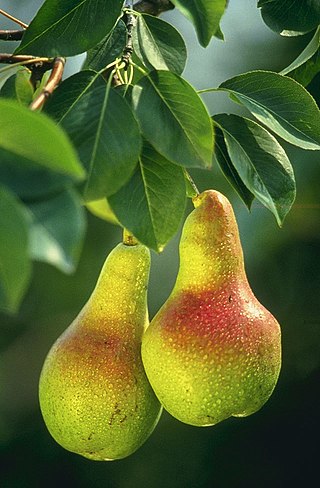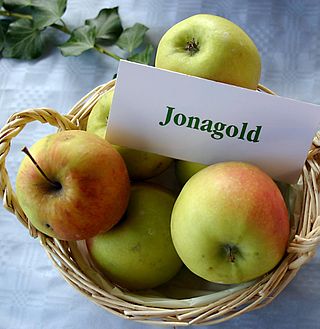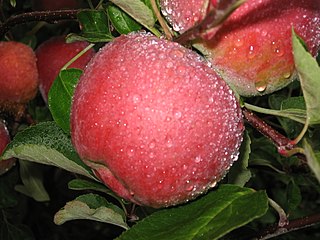
Kiwifruit or Chinese gooseberry, or yangtao, is the edible berry of several species of woody vines in the genus Actinidia. The most common cultivar group of kiwifruit is oval, about the size of a large hen's egg: 5–8 centimetres in length and 4.5–5.5 cm in diameter. It has a thin, fuzzy, fibrous, tart but edible light brown skin and light green or golden flesh with rows of tiny, black, edible seeds. The fruit has a soft texture with a sweet and unique flavour.

The McIntosh, McIntosh Red, or colloquially the Mac, is an apple cultivar, the national apple of Canada. The fruit has red and green skin, a tart flavour, and tender white flesh, which ripens in late September. In the 20th century, it was the most popular cultivar in Eastern Canada and New England, and is considered an all-purpose apple, suitable both for cooking and eating raw.

Fruit tree propagation is usually carried out vegetatively (non-sexually) by grafting or budding a desired variety onto a suitable rootstock.

Pyrus communis, the common pear, is a species of pear native to central and eastern Europe, and western Asia.

Jonagold is a cultivar of apple that is a cross between the crisp Golden Delicious and the blush-crimson Jonathan; the name Jonagold is a portmanteau of these two variety names. It was developed in 1943 in New York State Agricultural Experiment Station of Cornell University's College of Agriculture and Life Sciences, selected as N.Y. 43013-1 in 1953, officially released in 1968 by Roger Way.

Gravenstein is a triploid apple cultivar that originated in the 17th century or earlier. The fruit has a tart flavor, and it is heavily used as a cooking apple, especially for apple sauce and apple cider. It does not keep well, and it is available only in season. This is in part because neither cold storage, nor regular controlled atmosphere keeps the apples' distinctive aroma, although the Nova Scotia Fruit Growers' Association states that "recently however, low oxygen CA storage has shown promise in retaining this harvest-time quality".

Gala is an apple cultivar with a sweet, mild flavor, a crisp but not hard texture, and a striped or mottled orange or reddish appearance. Originating from New Zealand in the 1930s, similar to most named apples, it is clonally propagated. In 2018, it surpassed Red Delicious as the apple cultivar with the highest production in the United States, according to the US Apple Association. It was the first time in over 50 years that any cultivar was produced more than Red Delicious.

Honeycrisp is an apple cultivar developed at the Minnesota Agricultural Experiment Station's Horticultural Research Center at the University of Minnesota, Twin Cities. Designated in 1974 with the MN 1711 test designation, patented in 1988, and released in 1991, the Honeycrisp, once slated to be discarded, has rapidly become a prized commercial commodity, as its sweetness, firmness, and tartness make it an ideal apple for eating raw. "...The apple wasn't bred to grow, store or ship well. It was bred for taste: crisp, with balanced sweetness and acidity." It has larger cells than most apple cultivars, a trait which is correlated with juiciness, as larger cells are more prone to rupturing instead of cleaving along the cell walls; this rupturing effect is likely what makes the apple taste juicier. The Honeycrisp also retains its pigment well and has a relatively long shelf life when stored in cool, dry conditions. Pepin Heights Orchards delivered the first Honeycrisp apples to grocery stores in 1997. The name Honeycrisp was trademarked by the University of Minnesota, but university officials were unsure of its protection status in 2007. It is now the official state fruit of Minnesota. A large-sized honeycrisp will contain about 113 calories.

'Macoun' apples are a cross between the 'McIntosh' and 'Jersey Black' cultivars. The Macoun was developed at the New York State Agricultural Experiment Station in Geneva, by Richard Wellington. It was first introduced in 1932, and is an eating apple. This apple is excellent for making European style apple pies because it doesn't break down during cooking and remains firm. Macouns are also very popular at roadside stands and pick-your-own farms. Availability is generally October through November. Sugar 13%, acid 6g/litre, vitamin C 4mg/100g.

Esopus Spitzenburg or Aesopus Spitzenburgh is a variety of apple. It was discovered early in the 18th century near Esopus, Hudson, New York and is reputed to have been a favorite apple of Thomas Jefferson, who planted several of the trees at Monticello.

Peter Gideon (1820–1899) was a farmer near Excelsior, Minnesota, United States, who was responsible for breeding apples that could withstand Minnesota's climate. Gideon's farmhouse, now within the boundaries of Shorewood, Minnesota, is listed on the National Register of Historic Places.

Garden roses are predominantly hybrid roses that are grown as ornamental plants in private or public gardens. They are one of the most popular and widely cultivated groups of flowering plants, especially in temperate climates. An enormous number of garden cultivars have been produced, especially over the last two centuries, though roses have been known in the garden for millennia beforehand. While most garden roses are grown for their flowers, often in dedicated rose gardens, some are also valued for other reasons, such as having ornamental fruit, providing ground cover, or for hedging.

White Transparent is an early-season cultivar of apple which is usually used for cooking due to its sharp taste. It is sometimes said to be the same as 'Yellow Transparent', but 'Yellow Transparent' is sometimes described differently, with fine rather than coarse flesh, and a sub-acid rather than acid flavour. Weight 75 g,
Applecrabs are various hybrids between crabapples and apples. They are bred for varying reasons, including disease resistance and use in cold climates because they are often hardier than apple trees and their fruit has the good eating qualities of apples.

Red Astrachan is a cultivar of domesticated apple of either Russian or Swedish origin, which is an early season apple, juicy, tart and mealy texture with pleasant flavour, and use for eating, cooking and cider. It is medium-sized, crimson colored. As all the early season apples, it is not good for storage. It is known by several other names including 'Abe Lincoln', 'American Red', and 'Waterloo'.
Pam's Delight is an English cultivar of domesticated apple.

The MN55 cultivar apple developed by David Bedford, a senior researcher and research pomologist at the University of Minnesota's apple-breeding program, and James Luby, PhD, professor, Department of Horticultural Sciences, Horticultural Research Center, is a cross between Honeycrisp and MonArk (AA44), a non-patented apple variety grown in Arkansas.

Francis Peabody Sharp was a Canadian pomologist and businessman. He pioneered the controlled hybridization of apples to create new varieties suited to short seasons and cold winters. He owned large orchard and plant nursery businesses in the province of New Brunswick from which he shipped to Canada and the United States.
The New Brunswicker is a domestic apple cultivar developed in the 19th century by Francis Peabody Sharp for colder climates such as Eastern Canada. It is an all-purpose apple suitable for fresh eating and baking, but it does not store well.
















